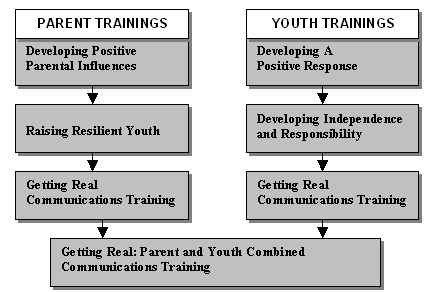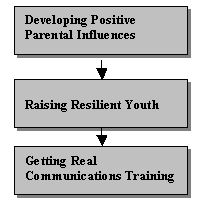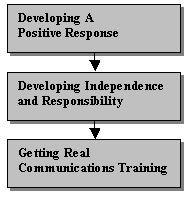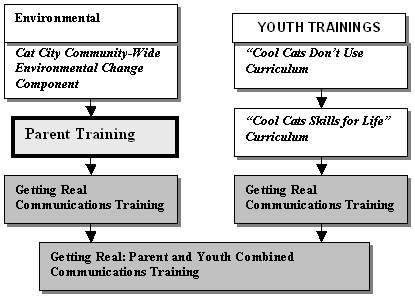Implementation Options for the Original CLFC Program
Creating Lasting Family Connections® in Both Prevention and Treatment Settings
By Ted N. Strader and Teresa A. Boyd
This article was first written for a 2002 National Prevention Network Conference presentation by Ted Strader & Teresa Boyd. It was first published in the 2002 NPN Conference Compendium. © Copyrighted by COPES, Inc. July 2002. Last updated in 2011.
The original Creating Lasting Family Connections® program has demonstrated results in reducing alcohol, tobacco and other drug (ATOD) use, delaying onset of ATOD use, and reducing uncontrolled and violent behavior with youth. The original program has been recognized as an effective evidence-based program by the Substance Abuse Mental Health Services Administration, the Center for Substance Abuse Prevention, the Office of Juvenile Justice and Delinquency Prevention, the U.S. Department of Education, the White House Office of National Drug Control Policy, the International Youth Foundation, and is listed on the National Registry of Evidence-based Programs and Practices (NREPP).
The original Creating Lasting Family Connections® program consists of 6 modules. The parent modules are: “Developing Positive Parental Influences”, “Raising Resilient Youth” and “Getting Real”. The 3 youth modules are: “Developing a Positive Response”, “Developing Independence and Responsibility”, and “Getting Real”. Each of the 3 individual parent trainings is a 5-6 session module with each session lasting from 1-1/2 to 2-1/2 hours depending on breaks and possibly including a meal. Each of the individual youth trainings is a 5-6 session module with sessions lasting 1 to 2-1/2 hours in length again depending on snacks, breaks and/or a meal being provided. (Sometimes it is very helpful for recruitment if families are provided meals in conjunction with the program.) An optional Parent and Youth combined “Getting Real” session usually requires an additional two or three sessions.
For maximum effectiveness, parents and youth are each involved simultaneously in their own separate three-module track lasting for 15 to 18 sessions.
The original Creating Lasting Family Connections® program is designed to be implemented in a diverse variety of settings. This program has demonstrated results with universal, selected and indicated populations.
Creating Lasting Family Connections® (CLFC’s) program developer specifically adapted the original version to serve the special populations of substance abuse recovery, prison reentry, fatherhood and healthy marriage. In quasi-experimental research studies with comparison groups, these adaptations have demonstrated strong statistically significant results in increasing critical fatherhood and relationship skills and drastically reducing prison recidivism.
Below we have outlined a number of different options for implementing the original CLFC program and the more recent, adapted versions.
Parent and Youth Training Module Description
CLFC parent and youth trainings
Figure 1: CLFC parent and youth trainings
Each of the parent training modules listed above ordinarily lasts about 5 or 6 weeks, with a single weekly 1.5 – 2.5-hour session (depending on availability of breaks and/or meals). Each of the youth training modules listed above lasts about 5 or 6 weeks, with a single 1.5-hour session per week. The optional parent and youth combined Getting Real communications training usually requires an additional two or three meetings (with each meeting lasting 2 to 2.5-hours). Therefore the complete original CLFC program runs anywhere from 14 – 20 sessions. We have found the trainings to be most effective when parents and youth are engaged in all six training modules consecutively and simultaneously. The trainers may present the modules in any order desired, but when implementing the modules with both parents and youth participants, it is important to pair the matching parent and youth modules.
Of the youth training components, Developing a Positive Response is designed to help youth build a foundation for making appropriate life decisions about ATOD use. The Developing a Positive Response training helps youth become aware of their deepest wishes for their own person health regarding alcohol, tobacco, and drugs, their relationships with their peers and family members, and their own yearning for success.
The next youth training component, Developing Independence and Responsibility, focuses on youth’s current level of responsibility within their family life, with an eye toward developing personal responsibility and independence for adulthood. This training exposes young people to the potential responsibility and independence they will have in the future. It is designed to motivate them to develop the skills necessary to succeed. It also helps young people to become more sensitive to the responsibilities their own parents currently face.
The third youth training component, Getting Real, is designed to help participants to understand a variety of universal communication styles, to recognize their own personal styles of communication, and to establish new and highly effective patterns of interaction with family members and peers that incorporate refusal skills, self-awareness, appropriate levels of trust and mutual respect.
For parents and other caring adults, there are also three separate training components. The first training, Developing Positive Parental Influences, is provided separate from, but simultaneously with, the youth training, Developing a Positive Response. In Developing Positive Parental Influences, parents and other caring adults are trained to effectively influence youth regarding a wide range of alcohol and drug issues through greater awareness of personal and cultural facts and feelings about alcohol and other drugs, as well as a greater understanding of intervention, referral procedures, and treatment options.
The next training component for parents and other adults, Raising Resilient Youth, is designed to enhance parents and other adults’ abilities to develop and implement effective expectations and consequences for youth in all areas of concern, including alcohol, tobacco and other drug use. The goal of this component is to help parents and caring adults see the value of having youth participate in setting effective and appropriate expectations and consequences. This tends to encourage dialogue and bonding between adult and child.
The third adult training module is the Getting Real Communications Training, which parallels the youth Getting Real Communications Training. Finally, as shown in the diagram, parents and youth come together in a combined Parent and Youth Getting Real Training. This is an important component because it allows the youth and adults to come together to both demonstrate and practice the skills they have already learned among their own peers.
School-based Options
In addition to the standard option, Creating Lasting Family Connections® has school-based implementation options, in which students (typically sixth to ninth graders) can complete the youth modules during the course of one school year or over the course of three school years. In the school-based implementation option, the parents of the students can be involved in the matching parent/adult modules during evening hours at the same time of year that students are receiving their version of the youth modules during school hours.
Figure 2 below shows the school-based options. This implementation option is similar to the community-based standard option (see Figure 1) except that it focuses on sixth to ninth graders. This option can be implemented either with parents and youth, or with youth only. The program can be implemented either over the course of a single school year or over three school years. The actual division of grades in which the modules are implemented depends upon the organizational structure of the school system involved.
Figure 2: School-based options
Other Options for Partial Implementation
Further, we have other options that acknowledge that in some situations either the parent/adult training components or the youth training components can be implemented without the other. For example, the parent training components (only) option might be used either for a group of parents or as training for social workers, youth service providers, or other adults who work with youth. Training these “impactors” can increase an agency’s ability to reach a large number of youth in a variety of settings. Similarly, the youth training components (only) option may be viable in either school settings or other organizational settings where parent participation may not be likely.
Many professional agencies enjoy tailoring their choices of CLFC modules for special populations and their families. For example, chemical dependency treatment centers often use selected modules for individuals and their families to address the intergenerational aspects of chemical dependency. We will review those options later in this paper.
Figure 3: Parent Trainings (only)/training of impactors option
Youth Trainings (only)
Figure 4: Youth Trainings (only)
Fidelity and Flexibility
While a high fidelity CLFC implementation would involve using the complete standard implementation option or the complete school based option, plus community mobilization and case management, this is not always possible or even desirable at the community level. A medium fidelity CLFC implementation might include the parent and youth training without case management services. A low fidelity implementation of CLFC might include only certain portions of the parent and/or youth training components.
Also, when choosing the level of fidelity to implement the CLFC program, it is important to understand that choosing a low fidelity level of implementation of CLFC does not necessarily mean the effort is no longer evidence-based. Instead, it simply refers to the concept that the implementation varies to a certain degree from the manner in which the original researched program was implemented. Later we will discuss why it is sometimes a better decision to go with a less than “high fidelity” replication in the real world.
We at COPES have come to the realization that it is important for agencies and organizations that want to implement evidence-based prevention programs like ours to have flexibility in selecting specific training modules to be used and how to structure the overall program implementation. For example, an organization or community may want to implement some additional prevention services in conjunction with those currently provided because a needs assessment has revealed some newly recognized risk and/or protective factors that have not been previously addressed. While some prevention programming is already in place, there are some noticeable gaps.
In a review of the CLFC targeted outcomes, the community leaders are excited about how CLFC addresses these key new issues. Yet, they also recognize some overlap because they are already successfully using an existing ATOD prevention program. In such cases, it may be beneficial for the community to continue using the existing ATOD prevention program, and combine it with other certain modules from CLFC in order to establish a more comprehensive prevention program for their community. Combining their existing prevention modules with several from CLFC not only creates a more comprehensive approach, it reinforces respect for the community investment in programs that they already see as their own. This is consistent with our primary belief that it is important in prevention efforts to take advantage of the strengths already present in a community.
It is critically important to note, however, that any training module or other component used with CLFC must be compatible in its general premises in order to avoid contradictory messages. Figures 5 and 6 illustrate two ways in which communities might integrate CLFC material into their existing prevention efforts. In the sample Figure 5, we will assume an agency has been using their own curriculum called “Cool Cats Don’t Use”. We will also assume upon review that this curriculum is quite compatible in concept, philosophy, and structure with CLFC programming. Rather than stop using “Cool Cats Don’t Use”, the agency might well want to supplement this effort with the remaining CLFC curriculum models in the shaded boxes. This can lead to very positive feelings among the agency or school personnel already using it. This can reduce resistance and strongly supplement an existing effort. Further, the program can be easily evaluated using the CLFC evaluation kit.
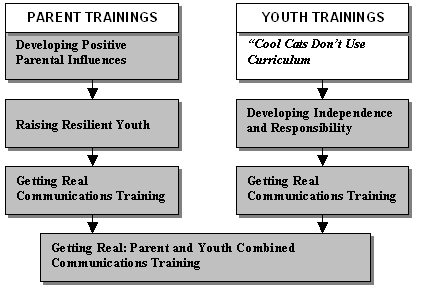
Figure 5: Sample Integration #1 (Note: CLFC Components shaded in gray.)
In sample Figure 6 below, a very different program design, the “Cat City Community-Wide Environmental Change” component, and two “Cool Cats” curriculums, the ATOD related “Cool Cats Don’t Use” and the “Cool Cat’s Skills for Life” Curriculum can be supplemented with the CLFC parent and youth communications training components. This again provides for a nice integration and a much more comprehensive approach. Further, the research in the field supports multiple prevention strategies with multiple opportunities across multiple domains in order to achieve results.
Figure 6: Sample Integration #2 (Note: CLFC Components shaded in gray.)
Next, Figure 7 below demonstrates one way chemical dependency treatment agencies are using the CLFC curriculum with families involved in recovery programs. Note how the recovering parent focuses on detox and early recovery before CLFC is initiated.
Figure 7 (Note: CLFC Components shaded in gray.)
In Figure 8 below, notice how the CLFC curriculum can also be used as part of an intervention or a recovery program. Developing Positive Parental Influences is often used for intervention training for all concerned persons prior to a family being involved in treatment. Next, treatment may be followed by other CLFC components as aftercare and providing prevention with their children. Finally, it is our belief that these types of implementation options by design really increase the ability of local providers to do an effective job in balancing all of the intricate issues of local ownership, integration of evidence-based programs and practices, and maintaining costs. In the next section we will examine a number of other issues that impact the implementation of any curriculum model.
Figure 8: Treatment Agency Option (Note: CLFC Components shaded in gray.)
Evaluation
The original CLFC program provides two options for evaluation. The first, is an evaluation kit designed to measure the effectiveness of the CLFC replications. This kit is based on the evaluation design and findings of the original CLC demonstration project. The CLFC evaluation kit is a comprehensive guide for measuring specific outcomes related to CLFC. The kit includes self-administered surveys for both youth and parents, the psychometric property scales in the surveys, survey administration and scoring guidelines, parent consent forms, and contact information for technical assistance on evaluating CLFC. The second evaluation option is a retrospective, post-test only version. This is a much more “user-friendly” means of assessing program outcomes with less complexity and scientific rigor required.
Issues That Impact Implementation
Staff Training and Technical Assistance Issues (See also CLFC National Training and Certification System)
Most curriculum developers face tough decisions regarding cost and quality control issues. With the CLFC curriculum series, training and technical assistance are not required, yet training is strongly recommended. Agencies interested in implementing any version of the CLFC curriculum are encouraged to complete a readiness assessment survey designed to determine the appropriate level of training needed.
Upon completion of surveys, the instrument is scored by comparing actual responses with desired responses. COPES’ staff then discusses these scores with the program manager considering CLFC training and negotiates a meaningful training plan by viewing training needs, training budget, schedules, and agency commitment. Typically a choice is made somewhere between a two-day training for a single module, a one-week training for the full curriculum, or a maximum of a two-week training for the program training and consultation (Most agencies find one-week of training sufficient). In addition to our 5- and 10-day training plans, we often provide customized trainings for groups on site that last 3, 4, 6, 8, or 9 days, based on results of the survey, the agency director’s discretion, or the agency budget.
For agencies who want to send staff to Louisville for training, the cost is $750 per person per week of training. The agency must also budget for staff travel, lodging and per diem. For custom, on-site training the cost can vary from as little as $1,500 per day depending on the number of trainers needed and their level of experience. The most commonly purchased CLFC onsite training service brings two CLFC Master Trainers to your local agency for $7,500.00 plus travel and expenses. In this case the agency must also budget for the trainer’s travel, lodging and $50.00 per day per diem.
Further, Master Trainer Training is available to staff who have already been certified as CLFC Implementation Trainers and who have successfully completed at least one implementation with positive results. Successful implementation familiarizes staff with the challenges involved in providing the CLFC program. This experience provides opportunity for both personal and professional growth, which are essential characteristics of a Master Trainer.
Once these steps are completed, staff can apply for the Master Trainer’s course or arrange with COPES to participate as a co-trainer with the CLFC developer. (Note: The Master Trainer certification process is similar in format to the CLFC Implementation Training, and includes multiple simulated training activities. This training examines implementation options, fidelity issues, advanced facilitator tips, guidelines for instructor certification, and tips on addressing implementation issues and challenges often presented by participants who are being trained to implement CLFC.)
Once certified, CLFC Master Trainers are empowered to conduct CLFC Implementation Training for their “home” agencies, and are also eligible to receive contracts from COPES to train others. These contracts from COPES enable staff or an agency to receive an honorarium for training conducted ($150 per day or more), plus travel and per diem expenses. The cost for becoming a Certified Master Trainer ranges from $0 to $2500 depending on staff’s availability, our experience with staff in the instructor certification training, demonstration of knowledge of the CLFC program, personality, and trainer characteristics that we believe are essential. Master Trainers on an agency’s staff can greatly reduce long-term training costs for an agency. Further, highly regarded Master Trainers can produce meaningful income for either themselves or their agency.
Training and technical assistance issues involve both dollars and staff time. Curriculum designers must find a balance between materials cost, training cost, training time and the need for quality control. It can be difficult, but it is important to recognize and describe the range of budgets that can truly be realistic for replicating any program. Grant writers often fail to create a realistic budget. At COPES, we often assist grant writers to create a realistic narrative and budget at the time of application at no charge. We do this because it increases our success in developing strong replications.
See also CLFC National Training and Certification System
Differing Target Populations: Cultural Sensitivity
The design of Creating Lasting Family Connections® is to draw on the “human experience” rather than to focus on any individual experience. Yet, the authors recognize that there are still limitations based on individual and cultural experiences. Therefore, the authors engineered cultural input from the targeted population by creating the Community Advocate Team (CAT) component as part of the community mobilization design. The CAT is expected to assist with “building a two-way bridge of understanding and acceptance between the participant population and the facilitator(s)” by teaching the program facilitators about the local cultural issues. This unique design feature has proved to be indispensable in overcoming cultural, social, and related differences between (and among) facilitators and participants. For a more detailed explanation of the CAT, please refer to pages 20, 86, and 87 in Building Healthy Individuals, Families, and Communities: Creating Lasting Connections published by Kluwer Academic/Plenum Publishers (Strader, Ted N., Collins, David C., and Noe, Tim D., 2000).

